- HubPages»
- Books, Literature, and Writing»
- Books & Novels»
- Nonfiction
Book Review - Sarah Payne A Mother's Story
Book Review - Sarah Payne, A Mother’s Story, written by Sara Payne with Anna Gekoski.
First published in 2004
Sarah Payne was the 8 year old child who tugged at Britain’s heartstrings when she went missing on July 1, in 2000. Her naked and decomposing body was discovered 17 days later in the middle of a grassy field. She died at the hands of paedophile monster, Roy Whiting, and this book tells the story of her birth, life, death and legacy, from her mother’s viewpoint.
The first half of the book tells of their earlier lives leading up to the disappearance, of the emotions and struggles her family went through when it happened, believing her to be lying injured somewhere, refusing to think the worst. Sara Payne describes frankly how she and her husband drank heavily to try to blot out the pain; how the police assigned the family liaison officers to keep them up to date with the search; how well they were looked after by everyone but they barely took it in as they struggled to come to terms with what was happening; how they held their other children closer during this dreadful time and since.
For a long time they blamed themselves. The day Sarah went missing, the family had gone down to the coast to visit the grandparents. In the early evening the children were playing on the shore, and pleaded with their parents to be left to play on their own while the parents visited a friend nearby.
Sarah Payne - A Mother's Story, at Amazon
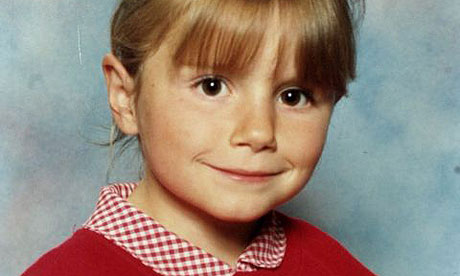
The abuction
It was the first time they had left Sarah and her little sister unsupervised, but their two older brothers were with them (aged 11 and 13) and so it was decided they could stay there alone, provided they all stayed together.
Sara Payne and her husband Mike dropped into the local pub for a quick half before heading back to the grandparents house at around 7.45pm.
Arriving there it was to find the family frantic as Sarah had disappeared. The book is really heart-wrenching at this point, as Sara describes her feelings of panic as she desperately searched the surrounding fields for her daughter, hoping against hope that the wee one was just hiding in the tall crops in the fields bordered by unruly hedgerows, the panic rising all the time as she knew her daughter was not the type of child to play this kind of game and would have been scared to be all alone.
Turns out the children had come off the beach and ambled back towards their grandparents home, stopping to play in a field next to the house. They had been playing some game or other, and Sarah had fallen and hurt herself, then ran off crying home. One of her older brothers had been in the process of running after her, when his other little sister got stung by nettles so he turned back to comfort her.
There was a clear line of sight between the field and the house, but when he turned round again to watch Sarah on her journey home, she had disappeared.

white van
He later told police he had seen a man in a white van nearby at the time, but didn’t pay much attention. He described the man as scruffy looking with a gap tooth, and this man had nodded and smiled in his direction.
The family searched everywhere that evening, asking neighbours in the community to help, and finally just before darkness fell, called the police. (In July it gets dark about 10 – 10.30pm).
A massive police search ensued, involving helicopters and hundreds of police officers, and when the story hit the Press it stayed top of the news items on all TV channels and newspapers for weeks. Sarah Payne’s face became as familiar as your own child’s, smiling out from the newsprints front pages day and day.
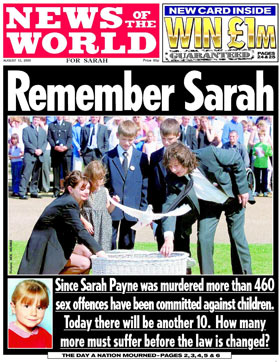

how her mum dealt with things
From the book, it seemed that the mother Sara seemed to be the one most in control. She makes reference to it several times how she felt she had to be strong for everyone, especially the children, and how she held herself together fearing that if she didn’t, she would not be able to accept the reality of it all and just go mad with grief.
It was she, therefore, who fielded most of the questions at Press conferences; she who dealt with the telephone ringing off the hook; she who dealt with the hordes of reporters camped outside their house.
Her husband dealt with his grief in a much more private way, and he just couldn’t face the crowds and the cameras most of the time.
The book goes on to describe the releasing of Sarah’s body for burial, the public and the private services held for her, and later the court case of the man accused of abducting and murdering Sarah, whose body was so badly decomposed it was difficult to impossible for the coroners to determine exactly how she died.
prayers
The whole country prayed for the safe return of this little girl, but it was not to be.
I cried along with the family reading this book.
It seems like every detail has been recorded in Sarah Payne – A Mother’s Story, every emotion for every minute of every day. Days when the parents couldn’t sleep unless they were drunk and even then it was not sleep, it was unconsciousness.
Sara describes in detail how all the family were affected, from the older boys who were eaten up with guilt to the little sister who kept asking when Sarah was coming home, to the parents who were going through a living nightmare with no end.

Roy Whiting trial
Roy Whiting denied his involvement all along, and he pled not guilty in court, but he was convicted on forensic evidence when fibres belonging to the clothes Sarah Payne had been wearing were matched to fibres found inside his van.
After his conviction, when he was sentenced to life imprisonment, it was admitted to the court that he was already on the Child Sex Offenders Register having been convicted of molesting a child once before.
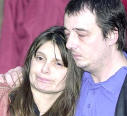
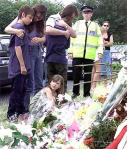
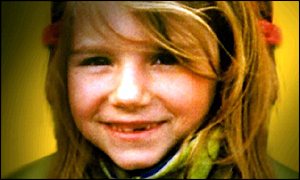
idea for Sarah's Law formed
In the days and weeks after the court case, with public interest in the case still high, several newspapers were badgering Sara to allow them exclusives, offering ridiculously high sums of money.
Sara and Mike discussed their offers at length in private, and jointly decided not to accept any of the offers, seeing it as ‘blood money’ and therefore tainted.
However, an idea was forming in Sara Payne’s mind. Her daughter had been murdered by a convicted child sex offender, and she felt that if the public were to be made aware of sex offenders living in the community, they would know, as parents, not to let their children out to play near them, or to make sure the children were adult supervised at all times for their own safety.
She felt that if they’d known Roy Whiting lived nearby, Sarah would be alive today.
She mentioned this idea to a reporter from the Rupert Murdoch-owned ‘News of the World’ whom she had come to know, while telling him the offer of an ‘excusive’ was off.
He called back later to say he had spoken to his editor, and that the paper were ready to give full backing to ‘Sarah’s Law’, to give the right to the community to know who is on the Sex Offenders register, similar to what had been passed in America, after the death of seven-year-old Megan Kanka who had been snatched and murdered on 29 July, 1994, by twice-convicted paedophile Jesse Timmendequas.
After this little girl’s death at the hands of their neighbour, who they had no idea was a convicted sex offender, the family campaigned for a change in the Law resulting in Bill Clinton introducing a new Law, dubbed Megan’s Law, just 89 days after her murder, giving parents the right to know when a convicted sex offender moved in amongst them.
Sara hoped she could persuade British politicians to adopt the same attitude, but despite paying her lip service, no such moves came about under Tony Blair’s government.
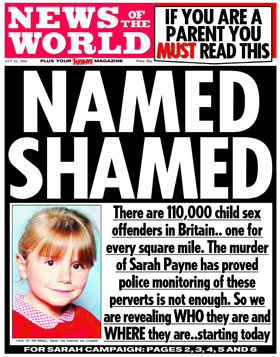
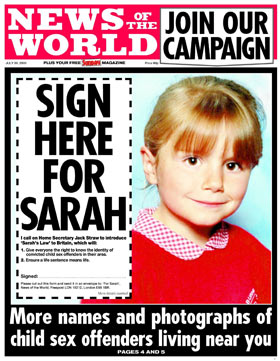
name and shame
During the course of this campaign, the News of the World took the decision to publish the names and addresses of convicted sex offenders on the register; 50 or so each week the campaign ran. Unfortunately this decision backfired when mobs of people targeted these houses, only to tar the wrong people because the register in many cases was out of date and offenders had moved, leaving new, innocent people to take the flak.
This only encouraged the government further in their stance that it was insecure to allow members of the public access to the Sex Offenders Register.
Over the course of the next few years, Sara Payne continued her fight and won the backing of the police federation amongst others. Talks were held and the original bill she asked for was watered down to ‘the right of someone responsible in the community to have access to the sex offenders register’, but obviously they would be sworn to silence lest word got out and the offender was then hounded out of his home only to go ‘underground’ where no-one could keep an eye on him.
new baby
The book finishes with the joy Sara and Mike found with the birth of a new daughter, Ellie.

Anna Gekoski is a British criminologist and authoress of several real-life crime books.
MBE
Footnote:
Nearly 10 years after Sarah Payne was murdered, Britain still has not introduced Sarah’s Law, but some small steps have been made towards it, with 15 new pieces of legislation passed going somewhere towards her goal.
Interestingly enough, Sara Payne now works at the Ministry of Justice, in central London, as a ‘Victim’s Champion’, and was recently awarded an MBE from the Queen for her for her long tireless fight for changes in the law to make Britain safer for all children.

Do you believe it;s your right to know if there is a paedophile living near you?
FOOTNOTE:
Just before Christmas, 2009, 40 year old Sara Payne suffered a stroke. Following surgery for an aneurism, she is now recovering although paralysed down the left side of her body.
I wish her well in her recovery, and I'm sure all the readers of the page will join me.









